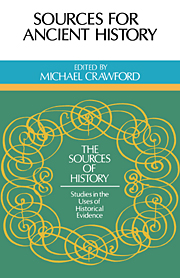2 - Epigraphy
Published online by Cambridge University Press: 06 January 2010
Summary
INTRODUCTION
There can have been few major civilisations in which the incision of words on stone or metal for permanent display or record has played no part at all. But if the making and display of inscriptions is attested in many cultures, it was so distinctive a feature of Graeco–Roman civilisation that it deserves consideration as a major cultural phenomenon in its own right. As a consequence of this, the sheer volume of inscriptions from the ancient world, primarily but not only in Greek and Latin, gives epigraphy a central importance in the study of its history and culture, in a way which is not characteristic of historical approaches to most other periods or areas. Thus, it was to an epigrapher of the classical world that the editors of a post–war French encyclopaedia turned when they wanted to include a section on epigraphy as a historical discipline in general.
The sheer profusion of epigraphic evidence – from tiny graffiti on walls or fragments of pottery, to stamps on jars, to the sepulchral inscriptions of innumerable individuals, to vast monumental inscriptions which may run to several hundred lines – creates its own problems. It would be a Herculean (and pointless) labour to work out even approximately how many Greek and Latin inscriptions have now been published; a guess of something over half a million might not be far out. Though many major projects for corpora of inscriptions have been undertaken – the great classics being the Corpus Inscriptionum Latinarum and to a lesser extent Inscriptiones Graecae – none ever has been, or ever could be, completed without being already out of date.
- Type
- Chapter
- Information
- Sources for Ancient History , pp. 80 - 136Publisher: Cambridge University PressPrint publication year: 1983
- 12
- Cited by



